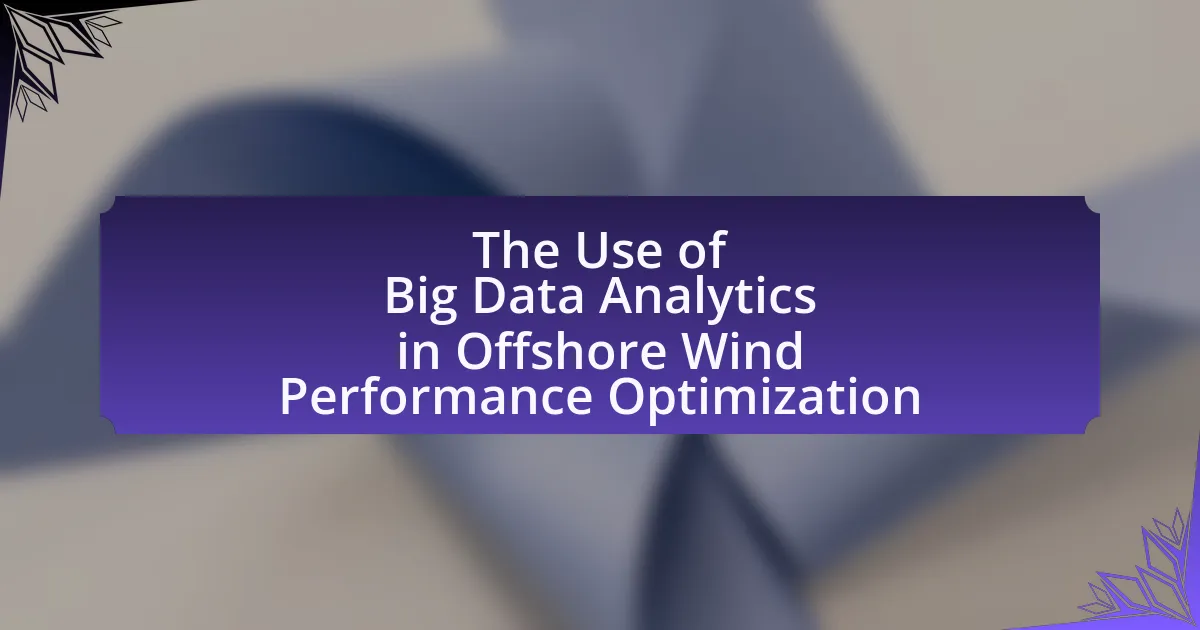The article focuses on the cybersecurity challenges faced by offshore wind energy systems, highlighting vulnerabilities to cyberattacks, data breaches, and threats to system integrity. It discusses the impact of these threats on operational integrity, financial losses, and safety risks, emphasizing the prevalence of ransomware, phishing, and DDoS attacks. The article also examines the regulatory frameworks in place to address these challenges, the role of emerging technologies like artificial intelligence and blockchain in enhancing security, and practical steps stakeholders can take to improve cybersecurity measures in the offshore wind sector.
What are the Cybersecurity Challenges in Offshore Wind Energy Systems?
Cybersecurity challenges in offshore wind energy systems include vulnerabilities to cyberattacks, data breaches, and system integrity threats. These systems often rely on interconnected technologies, making them susceptible to hacking, which can disrupt operations and compromise sensitive information. For instance, the European Union Agency for Cybersecurity reported that critical infrastructure, including energy systems, faces increasing cyber threats, with a notable rise in ransomware attacks targeting operational technology. Additionally, the remote locations of offshore wind farms complicate security measures, as physical access is limited, and monitoring can be challenging. The integration of Internet of Things (IoT) devices further amplifies these risks, as each connected device can serve as a potential entry point for cybercriminals.
How do cybersecurity threats specifically impact offshore wind energy systems?
Cybersecurity threats significantly impact offshore wind energy systems by compromising operational integrity and data security. These systems rely on interconnected technologies for monitoring and control, making them vulnerable to cyberattacks that can disrupt power generation, manipulate data, or cause physical damage to infrastructure. For instance, a report by the U.S. Department of Energy highlights that cyber incidents can lead to financial losses, operational downtime, and safety risks, emphasizing the critical need for robust cybersecurity measures in the offshore wind sector.
What types of cyber threats are most prevalent in offshore wind energy systems?
The most prevalent cyber threats in offshore wind energy systems include ransomware attacks, phishing schemes, and Distributed Denial of Service (DDoS) attacks. Ransomware attacks can disrupt operations by encrypting critical data, while phishing schemes target personnel to gain unauthorized access to sensitive information. DDoS attacks overwhelm network resources, leading to service outages. According to a report by the U.S. Department of Energy, the energy sector, including offshore wind, has seen a significant increase in these types of cyber threats, highlighting the urgent need for robust cybersecurity measures.
How do these threats compromise the integrity of offshore wind energy operations?
Cybersecurity threats compromise the integrity of offshore wind energy operations by exposing critical systems to unauthorized access and manipulation. These threats can lead to disruptions in power generation, data breaches, and potential physical damage to infrastructure. For instance, a successful cyberattack could manipulate control systems, resulting in turbine malfunctions or operational downtime, which directly impacts energy output and reliability. Additionally, the interconnected nature of offshore wind farms makes them vulnerable to widespread attacks, where a breach in one system can cascade and affect multiple operations, as evidenced by incidents like the 2020 cyberattack on a European wind farm that disrupted operations for several days.
Why is cybersecurity critical for the offshore wind energy sector?
Cybersecurity is critical for the offshore wind energy sector because it protects vital infrastructure from cyber threats that can disrupt operations and compromise safety. The offshore wind energy sector relies on complex digital systems for monitoring, control, and communication, making it vulnerable to cyberattacks that could lead to operational failures or data breaches. For instance, a report by the U.S. Department of Energy highlights that cyber incidents in energy sectors can result in significant financial losses and safety hazards, emphasizing the need for robust cybersecurity measures to safeguard against potential attacks.
What are the potential consequences of a cybersecurity breach in offshore wind energy systems?
A cybersecurity breach in offshore wind energy systems can lead to significant operational disruptions, financial losses, and safety hazards. Such breaches may compromise the control systems that manage turbine operations, potentially resulting in equipment damage or failure. For instance, a 2021 report by the U.S. Cybersecurity and Infrastructure Security Agency highlighted that cyberattacks on critical infrastructure, including energy systems, could lead to power outages and economic impacts estimated in the millions. Additionally, breaches can expose sensitive data, including proprietary technology and operational strategies, increasing the risk of intellectual property theft. The cumulative effect of these consequences can undermine public trust in renewable energy initiatives and hinder future investments in the sector.
How does cybersecurity affect the overall reliability of energy production?
Cybersecurity significantly impacts the overall reliability of energy production by protecting critical infrastructure from cyber threats that can disrupt operations. Cyberattacks on energy systems can lead to unauthorized access, data breaches, and operational failures, which compromise the stability and efficiency of energy production. For instance, the 2015 cyberattack on Ukraine’s power grid resulted in widespread outages, demonstrating how vulnerabilities in cybersecurity can directly affect energy reliability. Ensuring robust cybersecurity measures helps mitigate these risks, thereby enhancing the resilience and dependability of energy production systems.
What regulatory frameworks exist to address cybersecurity in offshore wind energy?
Regulatory frameworks addressing cybersecurity in offshore wind energy include the National Institute of Standards and Technology (NIST) Cybersecurity Framework, the European Union’s Cybersecurity Act, and the U.S. Department of Energy’s Cybersecurity Capability Maturity Model. These frameworks provide guidelines and standards for managing cybersecurity risks specific to energy infrastructure. For instance, the NIST Cybersecurity Framework offers a structured approach to identifying, protecting, detecting, responding to, and recovering from cybersecurity incidents, which is crucial for the operational integrity of offshore wind systems. The European Union’s Cybersecurity Act establishes a framework for cybersecurity certification, enhancing the security of network and information systems across member states, including energy sectors. The U.S. Department of Energy’s model helps organizations assess their cybersecurity capabilities and improve resilience against cyber threats.
How do these regulations influence cybersecurity practices in the industry?
Regulations significantly influence cybersecurity practices in the offshore wind energy industry by establishing mandatory compliance standards that organizations must follow. These regulations, such as the NIST Cybersecurity Framework and the EU’s General Data Protection Regulation, require companies to implement specific security measures, conduct regular risk assessments, and maintain incident response plans. Compliance with these regulations not only enhances the overall security posture of organizations but also fosters a culture of accountability and continuous improvement in cybersecurity practices. For instance, adherence to the NIST framework has been shown to improve risk management processes and reduce vulnerabilities in critical infrastructure sectors, including energy.
What role do international standards play in enhancing cybersecurity measures?
International standards play a crucial role in enhancing cybersecurity measures by providing a framework for best practices and guidelines that organizations can adopt to protect their systems. These standards, such as ISO/IEC 27001 and NIST Cybersecurity Framework, establish benchmarks for risk management, incident response, and security controls, ensuring a consistent approach to cybersecurity across different sectors. By adhering to these standards, organizations can improve their resilience against cyber threats, facilitate compliance with regulations, and foster trust among stakeholders. For instance, a study by the International Organization for Standardization found that organizations implementing ISO/IEC 27001 experienced a significant reduction in security incidents, demonstrating the effectiveness of international standards in bolstering cybersecurity.
What are the key vulnerabilities in offshore wind energy systems?
The key vulnerabilities in offshore wind energy systems include inadequate cybersecurity measures, physical security risks, and reliance on complex software systems. Inadequate cybersecurity measures expose these systems to potential cyberattacks, as evidenced by the increasing number of reported incidents targeting critical infrastructure. Physical security risks arise from the remote locations of offshore installations, making them susceptible to vandalism or sabotage. Additionally, the reliance on complex software systems for operations and monitoring can lead to vulnerabilities if not properly secured, as highlighted by studies indicating that software flaws can be exploited by malicious actors.
How do system architectures contribute to cybersecurity vulnerabilities?
System architectures contribute to cybersecurity vulnerabilities by creating complex interdependencies and potential points of failure within a system. These architectures often involve multiple components, such as hardware, software, and network elements, which can introduce weaknesses if not properly designed or secured. For instance, a study by the National Institute of Standards and Technology (NIST) highlights that poorly configured interfaces between system components can lead to unauthorized access and exploitation of vulnerabilities. Additionally, the integration of legacy systems with modern technologies can create security gaps, as older systems may lack the necessary updates or protections against contemporary threats.
What human factors increase the risk of cybersecurity incidents?
Human factors that increase the risk of cybersecurity incidents include lack of training, poor password practices, and social engineering susceptibility. Employees who are not adequately trained in cybersecurity protocols are more likely to make mistakes that can lead to breaches. For instance, a study by the Ponemon Institute found that 60% of data breaches are attributed to human error. Additionally, weak password practices, such as using easily guessable passwords or reusing passwords across multiple accounts, significantly heighten vulnerability. Furthermore, individuals who fall victim to social engineering tactics, such as phishing attacks, can inadvertently compromise sensitive information, as evidenced by the fact that 90% of successful cyberattacks begin with a phishing email, according to the 2021 Verizon Data Breach Investigations Report.
How can offshore wind energy systems enhance their cybersecurity posture?
Offshore wind energy systems can enhance their cybersecurity posture by implementing a multi-layered security approach that includes regular risk assessments, robust access controls, and continuous monitoring of network traffic. Regular risk assessments help identify vulnerabilities specific to offshore environments, while robust access controls ensure that only authorized personnel can access critical systems. Continuous monitoring of network traffic allows for the detection of unusual activities that may indicate a cyber threat. According to the National Renewable Energy Laboratory, the integration of these practices can significantly reduce the risk of cyber incidents in renewable energy systems.
What best practices should be implemented to mitigate cybersecurity risks?
To mitigate cybersecurity risks, organizations should implement a multi-layered security approach that includes regular software updates, employee training, and robust access controls. Regular software updates ensure that vulnerabilities are patched promptly, reducing the risk of exploitation. Employee training raises awareness about phishing attacks and social engineering tactics, which are common entry points for cyber threats. Robust access controls limit system access to authorized personnel only, minimizing the potential for insider threats and unauthorized access. According to the Cybersecurity & Infrastructure Security Agency (CISA), organizations that adopt these practices significantly reduce their risk of cyber incidents.
How can continuous monitoring improve cybersecurity in offshore wind energy systems?
Continuous monitoring enhances cybersecurity in offshore wind energy systems by providing real-time detection of anomalies and threats. This proactive approach allows for immediate response to potential cyber incidents, reducing the risk of data breaches and operational disruptions. For instance, continuous monitoring can identify unusual network traffic patterns indicative of a cyber attack, enabling swift mitigation actions. According to a report by the U.S. Department of Energy, implementing continuous monitoring can decrease incident response times by up to 50%, significantly improving the overall security posture of offshore wind facilities.
What emerging technologies can help address cybersecurity challenges in offshore wind energy?
Emerging technologies that can help address cybersecurity challenges in offshore wind energy include artificial intelligence (AI), blockchain, and advanced encryption methods. AI can enhance threat detection and response by analyzing vast amounts of data in real-time, identifying anomalies, and predicting potential cyber threats. For instance, AI-driven systems can monitor network traffic and flag unusual patterns that may indicate a cyber attack. Blockchain technology can improve data integrity and security by providing a decentralized ledger that is resistant to tampering, ensuring that operational data from wind turbines remains secure. Additionally, advanced encryption methods can protect sensitive information transmitted between offshore wind farms and onshore facilities, making it more difficult for unauthorized entities to intercept or manipulate data. These technologies collectively strengthen the cybersecurity posture of offshore wind energy systems, making them more resilient against evolving cyber threats.
How can artificial intelligence be leveraged for cybersecurity in this sector?
Artificial intelligence can be leveraged for cybersecurity in offshore wind energy systems by enhancing threat detection and response capabilities. AI algorithms can analyze vast amounts of data from network traffic and system logs to identify anomalies indicative of cyber threats, such as unauthorized access or malware activity. For instance, machine learning models can be trained on historical attack data to improve their predictive accuracy, enabling proactive measures against potential breaches. Research indicates that AI-driven systems can reduce incident response times by up to 90%, significantly mitigating the impact of cyberattacks on critical infrastructure.
What role does blockchain technology play in securing offshore wind energy systems?
Blockchain technology plays a crucial role in securing offshore wind energy systems by providing a decentralized and tamper-proof ledger for data management and transactions. This technology enhances cybersecurity by ensuring that all data related to energy production, maintenance, and operational protocols is securely recorded and cannot be altered without consensus from the network. For instance, the use of smart contracts on blockchain can automate and secure transactions between various stakeholders, reducing the risk of fraud and unauthorized access. Additionally, blockchain’s transparency allows for real-time monitoring of system integrity, enabling quicker responses to potential cyber threats. This capability is vital in an industry where operational disruptions can lead to significant financial losses and safety hazards.
What are the future trends in cybersecurity for offshore wind energy systems?
Future trends in cybersecurity for offshore wind energy systems include increased adoption of artificial intelligence for threat detection, enhanced regulatory frameworks, and a focus on supply chain security. The integration of AI allows for real-time monitoring and rapid response to cyber threats, improving the resilience of these systems. Regulatory bodies are likely to implement stricter cybersecurity standards, as evidenced by the European Union’s Cybersecurity Act, which aims to bolster the security of critical infrastructure. Additionally, as offshore wind energy systems become more interconnected, securing the supply chain against cyber vulnerabilities will be paramount, as highlighted by incidents in other sectors where supply chain attacks have led to significant disruptions.
How will evolving cyber threats shape the cybersecurity landscape in offshore wind energy?
Evolving cyber threats will significantly shape the cybersecurity landscape in offshore wind energy by necessitating enhanced security measures and protocols. As offshore wind energy systems become increasingly interconnected and reliant on digital technologies, they become more vulnerable to cyberattacks, which can disrupt operations and compromise sensitive data. For instance, the rise in ransomware attacks targeting critical infrastructure highlights the urgent need for robust cybersecurity frameworks tailored to the unique challenges of offshore wind energy. According to the U.S. Department of Energy, the energy sector has seen a 45% increase in cyber incidents over the past few years, underscoring the pressing need for advanced threat detection and response strategies in this sector.
What innovations are expected to enhance cybersecurity measures in the industry?
Innovations expected to enhance cybersecurity measures in the offshore wind energy industry include the implementation of artificial intelligence (AI) for threat detection, blockchain technology for secure data transactions, and advanced encryption methods. AI can analyze vast amounts of data in real-time to identify anomalies and potential threats, significantly improving response times to cyber incidents. Blockchain technology offers a decentralized and tamper-proof method for securing communications and transactions, which is crucial in protecting sensitive operational data. Advanced encryption methods ensure that data transmitted between systems remains confidential and secure from unauthorized access. These innovations are supported by industry trends indicating a growing reliance on AI and blockchain in cybersecurity, as evidenced by a report from Cybersecurity Ventures predicting that global spending on AI in cybersecurity will reach $46 billion by 2027.
What practical steps can stakeholders take to improve cybersecurity in offshore wind energy systems?
Stakeholders can improve cybersecurity in offshore wind energy systems by implementing a multi-layered security approach that includes regular risk assessments, employee training, and the adoption of advanced technologies. Conducting regular risk assessments helps identify vulnerabilities specific to offshore wind systems, allowing stakeholders to prioritize security measures effectively. Employee training ensures that personnel are aware of cybersecurity best practices and potential threats, reducing the likelihood of human error leading to breaches. Additionally, adopting advanced technologies such as intrusion detection systems and encryption protocols can enhance the security of data transmission and system integrity. According to the U.S. Department of Energy, integrating these practices can significantly mitigate risks associated with cyber threats in renewable energy sectors.




